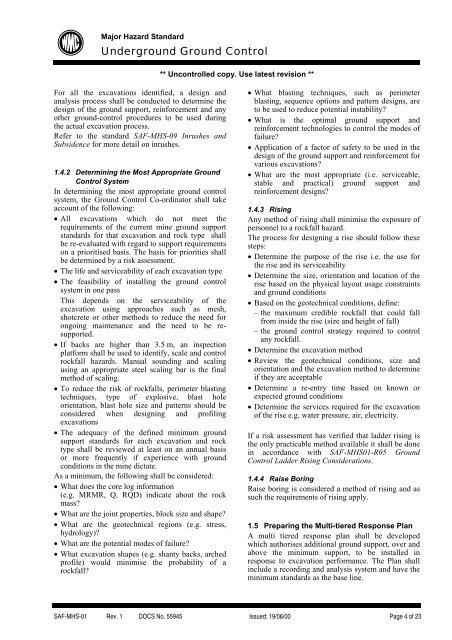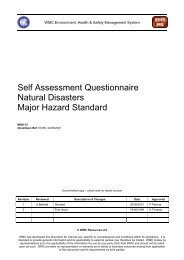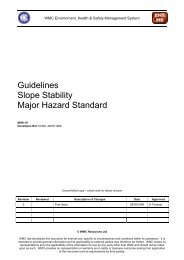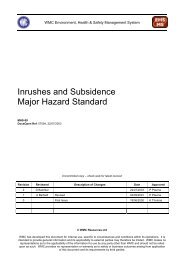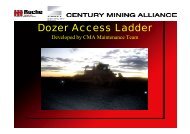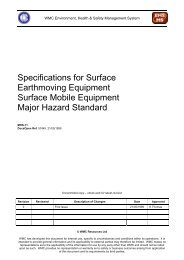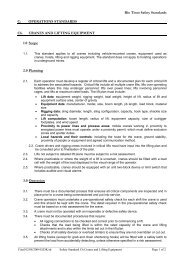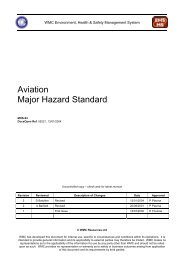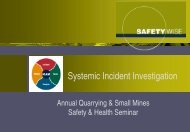Underground Ground Control Major Hazard Standard - MIRMgate
Underground Ground Control Major Hazard Standard - MIRMgate
Underground Ground Control Major Hazard Standard - MIRMgate
Create successful ePaper yourself
Turn your PDF publications into a flip-book with our unique Google optimized e-Paper software.
<strong>Major</strong> <strong>Hazard</strong> <strong>Standard</strong><strong>Underground</strong> <strong>Ground</strong> <strong>Control</strong>** Uncontrolled copy. Use latest revision **For all the excavations identified, a design andanalysis process shall be conducted to determine thedesign of the ground support, reinforcement and anyother ground-control procedures to be used duringthe actual excavation process.Refer to the standard SAF-MHS-09 Inrushes andSubsidence for more detail on inrushes.1.4.2 Determining the Most Appropriate <strong>Ground</strong><strong>Control</strong> SystemIn determining the most appropriate ground controlsystem, the <strong>Ground</strong> <strong>Control</strong> Co-ordinator shall takeaccount of the following:• All excavations which do not meet therequirements of the current mine ground supportstandards for that excavation and rock type shallbe re-evaluated with regard to support requirementson a prioritised basis. The basis for priorities shallbe determined by a risk assessment.• The life and serviceability of each excavation type• The feasibility of installing the ground controlsystem in one passThis depends on the serviceability of theexcavation using approaches such as mesh,shotcrete or other methods to reduce the need forongoing maintenance and the need to be resupported.• If backs are higher than 3.5 m, an inspectionplatform shall be used to identify, scale and controlrockfall hazards. Manual sounding and scalingusing an appropriate steel scaling bar is the finalmethod of scaling.• To reduce the risk of rockfalls, perimeter blastingtechniques, type of explosive, blast holeorientation, blast hole size and patterns should beconsidered when designing and profilingexcavations• The adequacy of the defined minimum groundsupport standards for each excavation and rocktype shall be reviewed at least on an annual basisor more frequently if experience with groundconditions in the mine dictate.As a minimum, the following shall be considered:• What does the core log information(e.g. MRMR, Q, RQD) indicate about the rockmass?• What are the joint properties, block size and shape?• What are the geotechnical regions (e.g. stress,hydrology)?• What are the potential modes of failure?• What excavation shapes (e.g. shanty backs, archedprofile) would minimise the probability of arockfall?• What blasting techniques, such as perimeterblasting, sequence options and pattern designs, areto be used to reduce potential instability?• What is the optimal ground support andreinforcement technologies to control the modes offailure?• Application of a factor of safety to be used in thedesign of the ground support and reinforcement forvarious excavations?• What are the most appropriate (i.e. serviceable,stable and practical) ground support andreinforcement designs?1.4.3 RisingAny method of rising shall minimise the exposure ofpersonnel to a rockfall hazard.The process for designing a rise should follow thesesteps:• Determine the purpose of the rise i.e. the use forthe rise and its serviceability• Determine the size, orientation and location of therise based on the physical layout usage constraintsand ground conditions• Based on the geotechnical conditions, define:– the maximum credible rockfall that could fallfrom inside the rise (size and height of fall)– the ground control strategy required to controlany rockfall.• Determine the excavation method• Review the geotechnical conditions, size andorientation and the excavation method to determineif they are acceptable• Determine a re-entry time based on known orexpected ground conditions• Determine the services required for the excavationof the rise e.g. water pressure, air, electricity.If a risk assessment has verified that ladder rising isthe only practicable method available it shall be donein accordance with SAF-MHS01-R05 <strong>Ground</strong><strong>Control</strong> Ladder Rising Considerations.1.4.4 Raise BoringRaise boring is considered a method of rising and assuch the requirements of rising apply.1.5 Preparing the Multi-tiered Response PlanA multi tiered response plan shall be developedwhich authorises additional ground support, over andabove the minimum support, to be installed inresponse to excavation performance. The Plan shallinclude a recording and analysis system and have theminimum standards as the base line.SAF-MHS-01 Rev. 1 DOCS No. 55945 Issued: 19/06/00 Page 4 of 23


